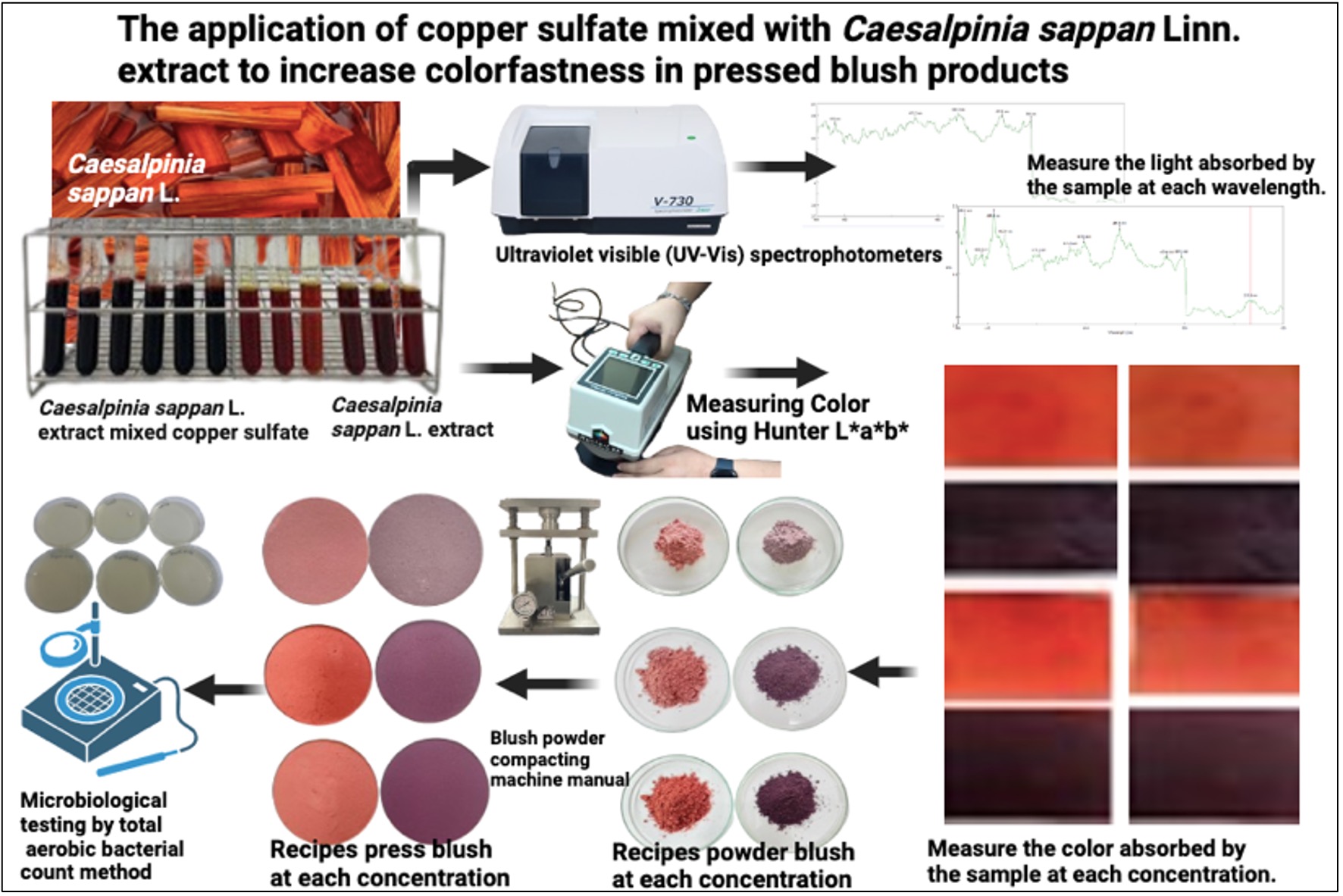The application of copper sulfate mixed with Caesalpinia sappan L. extract to increase colorfastness in pressed blush products
DOI:
https://doi.org/10.55674/cs.v16i3.256309Keywords:
Caesalpinia sappan L., Mordant, Pressed powder blushAbstract
This study aims to increase the colorfastness of pressed blush products by combining copper sulfate with Caesalpinia sappan L. extract. This experiment consisted of four conditions used for color extraction: 70% w w-1, 95% w w-1, 70% w w-1 with 10% w w-1 copper sulfate, and 95% w w-1 with 10% w w-1 copper sulfate. The highest yield percentage of crude extract was found at 70% w w-1, with the highest absorption value (λmax) at 70% methanol with 10% w w-1 copper sulfate. The darkest shade of red was found at 70% w w-1 with 10% w w-1 copper sulfate. The development of pressed blush occurred when corn starch was mixed with more white color and smell than arrowroot flour. The highest red color was achieved at 4.5% w w-1, with the highest red - purple intensity. The microbial contamination test showed no microbial contamination in pressed blush products.
GRAPHICAL ABSTRACT

HIGHLIGHTS
- Caesalpinia sappan L. was extracted using maceration methods with methanol solvent. Phytochemical screening revealed pink anthraquinone and anthocyanidins. The chemical properties showed a pH range of 5.31–5.74, maximum light absorption, and mordant increased absorption. A compress blush was developed with corn starch and arrowroot flour, suitable for the cosmetic industry.
References
S. Suci, D. Ratna, F. Faizatun, Formulation of blush preparations by using natural coloring from red beetroot extract (Beta vulgaris L.), Indones. J. Chem. 2 (2021) 860. 10.22146/ijc.60414.
F. Afrose, Colour fastness properties of mordants and mordanting methods when dyed with used tea leaves on silk fabric, Int. J. Eng. Sci. Res. Technol. 4 (2015) 512 – 518.
J.M. Jabar, A.I. Ogunmokun, T.A.A. Taleat, Color and fastness properties of mordanted Bridelia ferruginea B. dyed cellulosic fabric, Fash. Text. 7 (2020) 1 – 13.
M.R. Miah, F.Y. Telegin, M.S. Miah, M.A. Shahid, M.S. Rahman, J. Ran, Comparative analysis of colour strength and fastness properties on extracts natural dye from onion's outer shell and its use in eco-friendly dyeing of silk fabric, Int. J. Photochem. Photobiol. 1 (2017) 1 – 8.
K. Piyaporn, W. Kritsana, J. Siriluk, Dyeing properties and color fastness of eri silk yarn dyed with soaked red kidney bean water, J. Met. Mater. Miner. 30 (2020) 51 – 59.
O. Rina, S. Ibrahim, A. Dharma, A. Afrizal, C.W. Utami, Y.R. Widodo, Stabilities natural colorant of Sappan wood (Caesalpinia sappan L.) for food and beverages in various pH, temperature, and matrices of food, Int. J. ChemTech. Res. 10 (2017) 98 – 103.
Y. Yuyun, D.A. Dhiya, N. Eric, Q. Lailatul, Parametric study and characterization of Sappan Wood (Caesalpinia sappan Linn) natural red colorant extract with ultrasonic assisted extraction method, ASEAN J. Chem. Eng. 23 (2023) 103 – 112.
W. Kaewpuk, Study of the natural dyes from plants for chromosome staining in a biological laboratory, The 7th NPRU Nat. Conf. 7 (2018) 30 – 31.
ASTM., Soil stabilization using waste plastic materials, J. Civ. Eng. 10 (2016) 16 – 17.
B. Suphim, P. Chumsri, O. Panphet, Microbiological quality of ready-to-eat foods in Loei rajabhat university canteen, J. Sci. Tech. UBU. (2011) 72 – 81.
N. Peamaroon, N. Moonrungsee, A. Boonmee, S. Suwancharoen, T. Kasemsuk, J. Jakmunee, Phytochemical and xanthine oxidase inhibitory activity of Carissa carandas L. fruit extract, RMUTP Res. J. 13 (2019) 106 – 118.
F. Fakgoen, M. Meerod, Extraction and separation of anthocyanins from Carissa carandas L, The 4thRes. Dev. Inst. KPRU Nat. Conf. 4 (2017) 1002 – 1011.
W. Anting, T.C. Sunarti, F. Farah, E. Toshiharu, The potential of bioactives as biosensors for detection of pH, IOP Conf. Ser.: Earth Environ. Sci. 460 (2020) 1 – 14.
L. Kongplee, P. Pangsri, The development of natural dry from plants in anthocyanin group for staining plant tissue, J. Sci. Educ. 5 (2022) 1 – 11.

Downloads
Published
How to Cite
Issue
Section
Categories
License
Copyright (c) 2024 Creative Science

This work is licensed under a Creative Commons Attribution-NonCommercial-NoDerivatives 4.0 International License.








